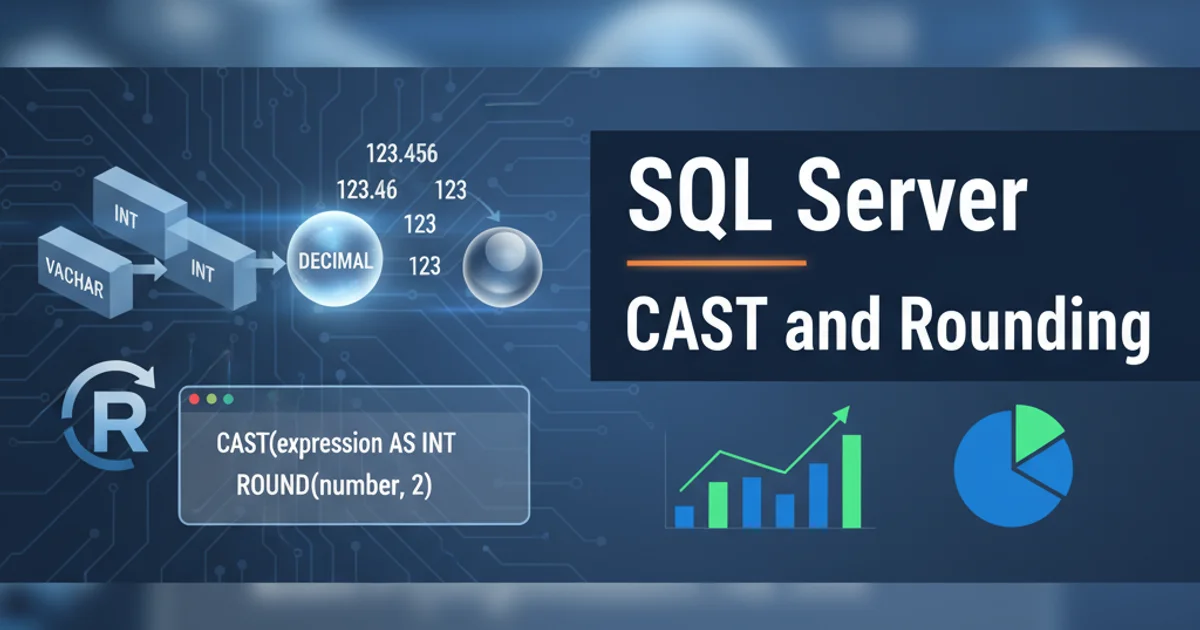SQL Server Cast and Rounding
Mastering CAST and ROUND in SQL Server

Learn how to effectively use SQL Server's CAST function for data type conversions and various rounding techniques for numerical precision.
In SQL Server, managing data types and numerical precision is crucial for accurate data manipulation and reporting. Two fundamental functions that play a significant role in this are CAST and ROUND. The CAST function allows you to convert an expression from one data type to another, which is essential for ensuring data compatibility and preventing implicit conversion errors. The ROUND function, on the other hand, provides precise control over numerical values, enabling you to round numbers to a specified length or precision.
Understanding the CAST Function
The CAST function is a powerful tool for explicit data type conversion in SQL Server. It takes an expression and converts it to a specified target data type. This is particularly useful when you need to perform operations that require specific data types, or when you want to control how data is stored or displayed. Unlike implicit conversions, CAST gives you explicit control, making your queries more robust and predictable.
SELECT
CAST('123' AS INT) AS CastToInt,
CAST(123.45 AS DECIMAL(5, 2)) AS CastToDecimal,
CAST(GETDATE() AS DATE) AS CastToDate,
CAST(1 AS BIT) AS CastToBit;
Basic examples of using the CAST function for various data type conversions.
CAST for explicit conversions to avoid unexpected behavior from implicit conversions, especially when dealing with different data types in comparisons or arithmetic operations. This improves query readability and maintainability.flowchart TD
A["Input Value (e.g., '123.45')"]
B["Target Data Type (e.g., DECIMAL(5,2))"]
C{"CAST Function"}
D["Converted Value (e.g., 123.45)"]
A --> C
B --> C
C --> DConceptual flow of the CAST function converting an input value to a target data type.
Exploring the ROUND Function
The ROUND function in SQL Server is used to round a numeric expression to a specified length or precision. It's essential for financial calculations, statistical analysis, and any scenario where precise numerical representation is required. The function takes two main arguments: the numeric expression to be rounded and the length (number of decimal places) to which it should be rounded. An optional third argument allows for truncation instead of rounding.
SELECT
ROUND(123.456, 2) AS RoundedToTwoDecimalPlaces, -- Result: 123.460
ROUND(123.456, 0) AS RoundedToInteger, -- Result: 123.000
ROUND(123.456, -1) AS RoundedToTensPlace, -- Result: 120.000
ROUND(123.456, 2, 1) AS TruncatedToTwoDecimalPlaces; -- Result: 123.450
Examples demonstrating different rounding and truncation scenarios with the ROUND function.
ROUND. If it's present and non-zero, ROUND truncates the number instead of rounding it. This can lead to unexpected results if not used intentionally.Combining CAST and ROUND for Advanced Precision
Often, you'll need to combine CAST and ROUND to achieve specific data formatting and precision requirements. For instance, you might need to round a calculated value and then cast it to a specific decimal type for storage or display. This combination ensures that both the precision and the data type are correctly handled, preventing data loss or unexpected formatting.
DECLARE @Value FLOAT = 123.456789;
SELECT
ROUND(@Value, 2) AS RoundedValue, -- FLOAT result
CAST(ROUND(@Value, 2) AS DECIMAL(10, 2)) AS CastAndRoundedValue, -- DECIMAL result
CAST(@Value AS DECIMAL(10, 2)) AS CastOnlyValue; -- DECIMAL result, rounded by CAST
-- Example with a calculation
SELECT
CAST(ROUND(SUM(OrderTotal) / COUNT(OrderID), 2) AS DECIMAL(10, 2)) AS AverageOrderValue
FROM Sales.Orders;
Combining CAST and ROUND for precise numerical representation and data type control.
sequenceDiagram
participant Data as "Raw Data (FLOAT)"
participant Round as "ROUND Function"
participant Cast as "CAST Function"
participant Output as "Final Output (DECIMAL)"
Data->>Round: Numeric Expression
Round-->>Cast: Rounded Value (e.g., 123.46)
Cast->>Output: Converted Value (e.g., 123.46)Sequence of operations when combining ROUND and CAST for data precision.